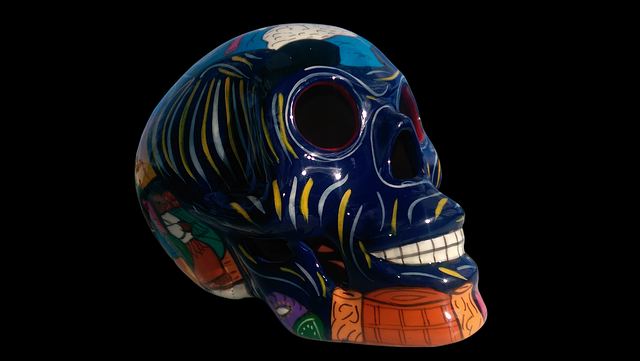
A special holiday celebrated all throughout Mexico, that is also a public holiday, is the “Day of the Dead” which is known in Spanish as Di’a de Muertos or in English speaking countries(Anglophone countries) with Mexican populations as Di’a de los Muertos. On this solemn day, Mexicans honor their deceased loved ones with the belief that their spirits return on this one day of the year to be reunited with the families.
This special celebration, a joyful affair, often starts on October 31st, continues of November 1 and runs through November 2. Di’a de los Muertos originated in Mexico thousands of years ago. Traditionally held by the Native Central American Indians of Mexico during the beginning of summer, which was considered in August, centuries ago the Spanish conquerors of the nation gradually changed the time of the festival to coincide with 3 important traditional European holidays that deal with the dead: October 31st Christianized Halloween also known as All Saints’ Eve or Evening, November 1 also known as All Saints’ Day and the last day following November 2 also known as All Soul’s Day(to honor deceased Christian souls).There are some people who observe Nov.1 as All Souls’ Day and Nov. 2 as All Saints’ Day.
If November 2 falls on a Sunday, the Catholic Mass is of All Souls, but the Office is that of the Sunday. The Day of the Dead. itself, is actually just on November 2, but celebrants have linked together October 31st, November 1 and November 2 to form a 3 day lineup. The 3 days of All Hallowtide. Mexicans, in different countries, celebrate the festive, especially during the 3 days. On November 1, Mexicans place special emphasis on observing infants and children who are deceased. This memorial day is known as Di’a de los Inocentes(Day of the Innocents) or Di’a de los Angelitos(Day of the Little Angeles). On November 2, Mexicans place special emphasis on adults who are deceased.(Di’a de los Muertos).
The Day of the Dead celebration is based on the ancient rituals of the Aztecs of Mexico who honored the goddess Mictecacihuath known as the “Lady of the Dead” and their observance lasted a month. The ancient Azetcs also honored the spirits of deceased family members. Azetcs today observe the Day of the Dead.

With modern participants of the festival, people in large communities will take to the streets where a parade is held for the spirits, with the marchers dressed up in spooky looking costumes and other costumes associated with things of death including skeletons, bloody bodies, decomposing corpses, etc. People will also hold indoor and outdoor parties, consuming alcohol and indulgent foods, expecting the spirits to attend. folks, at times, wear wooden skull masks, known as calacas. For children, toys and food, including breads , candies, and cakes are made in the shape of symbols of death such as skulls and skeletons. Sugar skulls are often inscribed with the name of the dearly departed on the top. A belief is that the spirits consume the essence and the aroma of the foods that are offered when the spirits depart, the living folks eat the food and share any extras with their family, friends, and good neighbors. Families have elaborately decorated shrines or altars to the deceased, called ofrendas, in their homes, adorned with photos of the deceased, lit candles, flowers, and food, especially favorite foods and beverages the deceased showed fondness for.

The populace of the festival also adorn grave sites of beloved ones with lit candles, marigolds(which are in season then), and the favorite foods and beverages of the deceased to coax the spirit to return to the grave as family members will wait, for a long time, sometimes many hours or even the whole night in the cemetery while the living party, have a picnic supper, play music, talk, and drink through the night. A common belief is the spirit first visits the grave before visiting family residences.
https://en.wikipedia.org/wiki/Day_of_the_Dead
https://wwww.tripsavvy.com/day-of-the-dead-in-mexico-1588764
https://www.britannica.com/topic/Day-of-the-Dead


